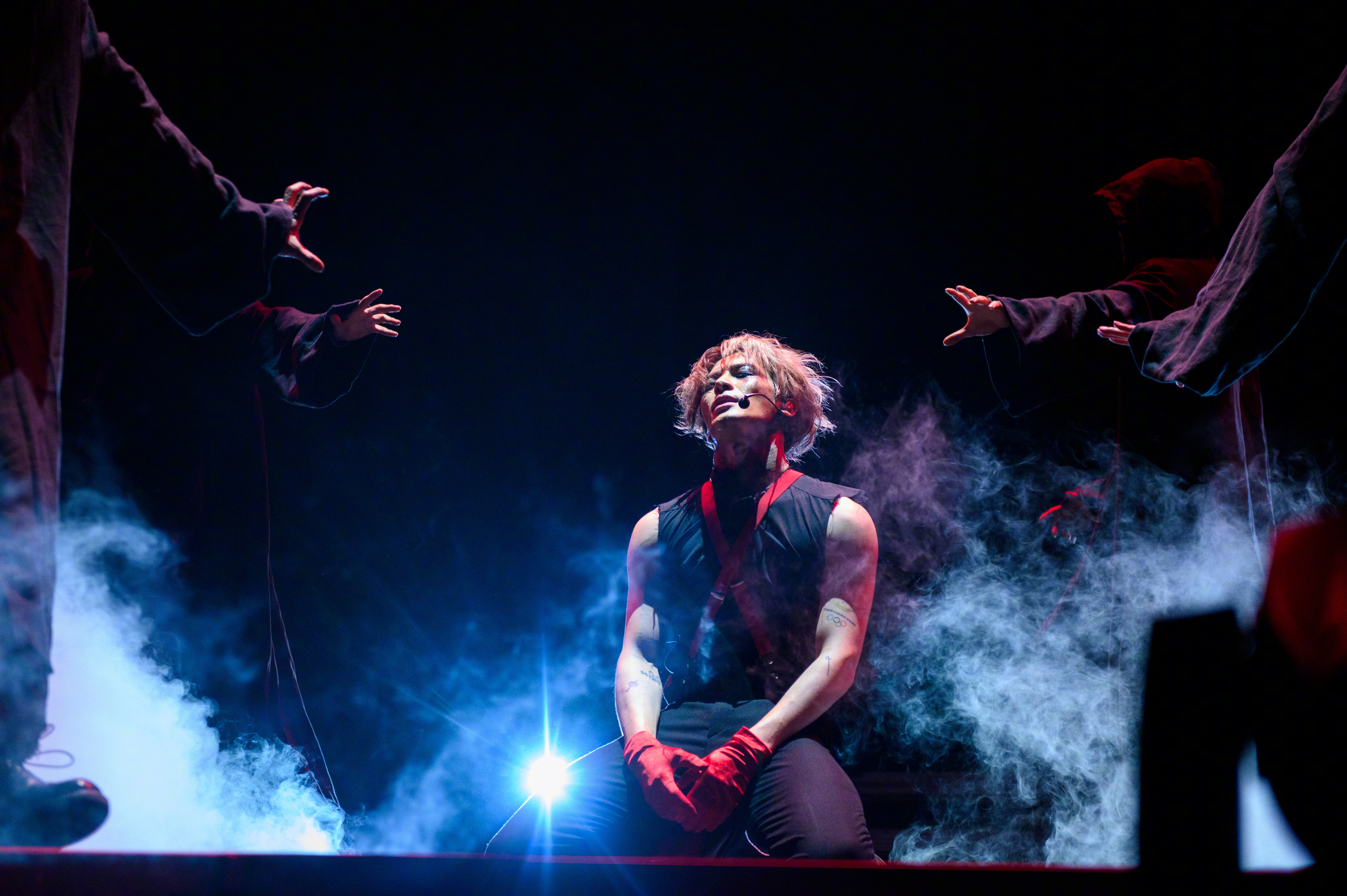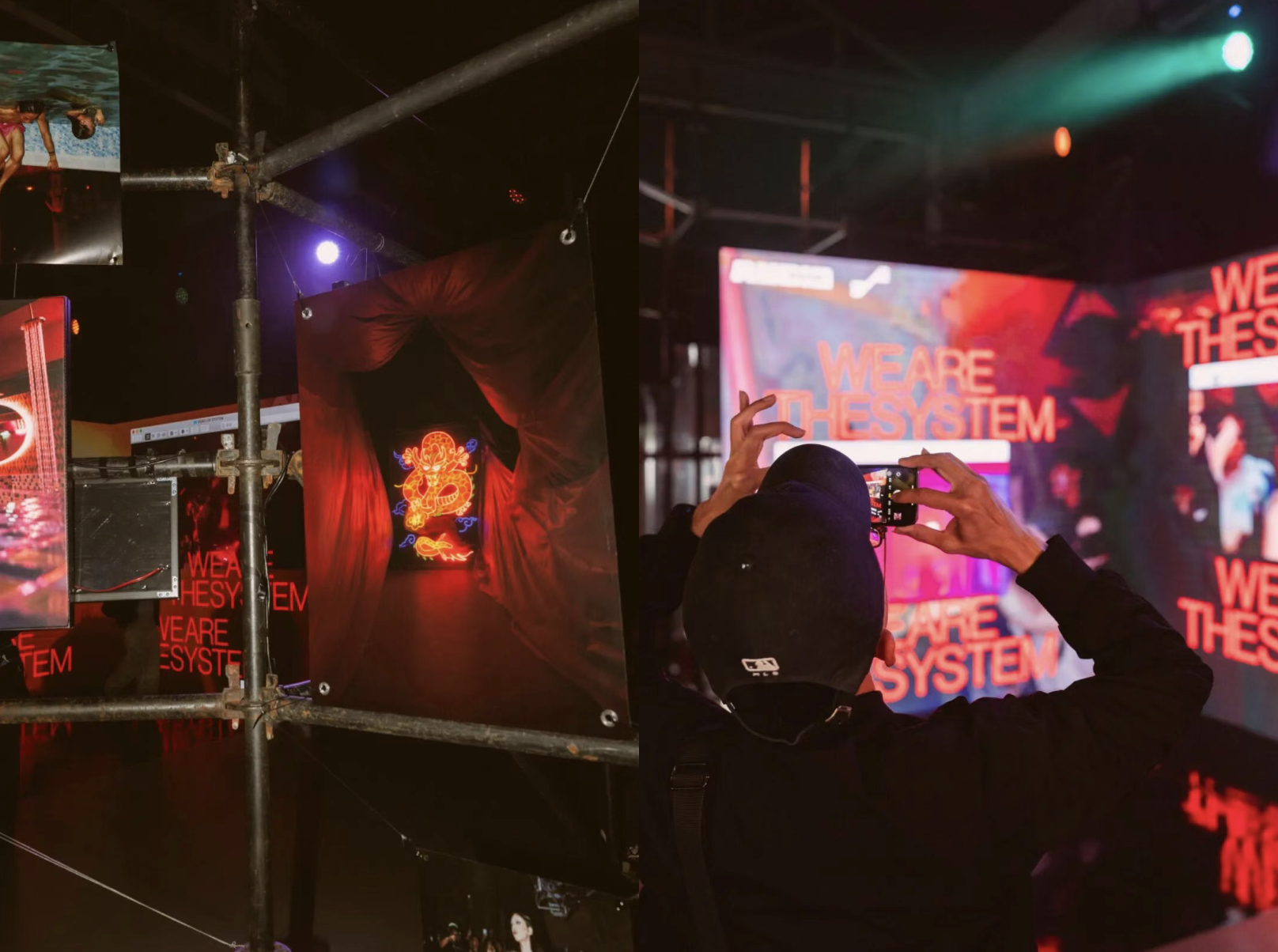Between the two of them, Han Han and Wu Shanmin — who goes by “San San,” short for 33EMYBW, her solo alias and online handle — have set deep and wide roots in Shanghai’s underground cultural scene. 33 started making music in 2002, playing guitar and bass in seminal Shanghai bands 33 Dao, Booji, and Muscle Snog. Many of these bands’ releases came out on Miniless, the DIY music label launched by Han Han in 2006, which went quiet in 2010 after releasing around 20 albums from artists in Shanghai and nearby cities. One key Miniless release was the debut EP for what is now among Shanghai’s best-known bands, Duck Fight Goose, co-founded by Han Han and 33 in 2009.
While 33 and Han Han both come from a rock background, their band and personal influences have both gravitated toward a more eclectic, electronic sonic palette over time. This reflects a broader cultural characteristic of Shanghai, where internationally informed, locally brewed strains of mutant electronic dance music are being concocted in venues like ALL and by groups such as Shanghai Community Radio.
 Yin: Sci-Fi Flavored Future-Rock from Shanghai’s Duck Fight GooseArticle Nov 02, 2017
Yin: Sci-Fi Flavored Future-Rock from Shanghai’s Duck Fight GooseArticle Nov 02, 2017
In recent years, Han Han and 33 have invested heavily in the electronic, internet-inflected aspects of their art. In 2016 they came out with CLVB ZVKVNFT, a sprawling concept album by Duck Fight Goose fusing a cyberpunk, sci-fi narrative with a refreshed sound much heavier on synthesizers and software patches. That gear is Han Han’s domain — over the last few years he’s become a sort of sound scientist, experimenting with towers of modular synths and byzantine blocks of code to create his own customized instrument, which he describes as a “living system” and which he releases under the name Gooooose (pronoun: they).
Since May of last year, 33 has also been tinkering with solo music production, soundtracking visual collage art made on her phone with music that she describes as “fun, kind of danceable, and interesting,” a sound analog to her often outlandish visual works. (She’s the creative director of Shanghai fashion brand Zuczug by day.) Her debut EP (as 33EMYBW), Medusa, along with Gooooose’s latest album, were just released by D Force Records, a vinyl, CD and digital label launched in 2015 by the music-nerd-approved social network Douban.
I caught up with 33EMYBW and Han Han in Douban’s freshly renovated office space in Beijing to talk about their new music, how machines can be organic, how spiders are like robots, and why Shanghai might be China’s most progressive city for new music:

RADII: Han Han, you’ve been working on solo material for several years now under the name Gooooose. How has your sound changed in the last few years?
Han Han: I’ve always been interested in working outside of a band, using different kinds of gear — computers, customized software programs, using these to make music. I’m really into customizing stuff, not using things from others. I would say the biggest change in my music has been the result of this, because I started to make my own software instruments and plugins about two years ago, and that was when I really started to think about what kind of [music-making] process is my favorite. I think somehow, the tools that I made pushed my music in a certain direction, which I like. So the music kind of evolved from a mashed potato of all kinds of sound, to now, where it’s more like improvisation, real-time composition, real-time sound synthesis. And also, real-time visual generation, generated from the sound, and the sound is generated from the program. Almost like a living system. I think that’s what happened to my music.
And you, 33? How has your solo project developed in the last year, leading up to your debut release on D Force?
33: My solo project started from the middle of last year. It’s related to another project I started two years ago, which focused on visual production of photo collages, mostly using smartphone apps. I’d make these collages in 20-45 minutes, and the music is kind of an outgrowth of that project. Since last May I’ve played at a few clubs and galleries. The key to my music is it has to be fun, it has to be kind of danceable, and it has to be interesting. Nothing apart from that really matters to me. For this new EP, I didn’t plot out a big, complicated concept like what Duck Fight Goose did last time. It’s more focused on the music itself, and the live experience. It’s more based on instinct.

What’s the concept behind the album art for each release? I think both of your music intersects with art, fashion and technology in different ways, which are partially reflected in the images you’ve chosen here…
Han Han: For my album, it’s some kind of a creature. It looks a little bit like a jellyfish, a little bit like a person. It’s a combination of a lot of different kinds of things. One concept is that, because I’m using a lot of hardware to make this music, I would say mostly that it’s machine music. Of course I’m playing it, but sometimes, especially when I’m patching, I can feel that the music has a sort of organic element to it. I’m not talking about “analog,” because many of my machines are purely digital, but through my patching system, or designing how the signal flows, something unpredictable happens. There’s a lot of noise, lots of controlled randomness. Those are things where you sort of know where it goes, but you don’t know how, or at what speed, or with what result.
It’s sort of like how you know that people will definitely get older, but you’ll never know what the result will be. So I kind of treat all the machines like creatures, and that’s what’s on the cover, sort of. Also, I made the cover in Adobe Illustrator, a 2D design software, but I tried to make it more 3D, give people a 3D feel. I didn’t use clean lines, I made them look softer, more like it was painted. So it’s kind of like a metaphor for the music.
And for you 33, your album cover is consistent with the smartphone-generated images you were talking about earlier, and which you also post to your social media. Can you talk about the art that’s coming out with your new release?
33: The cover art is also like a creature, on a beach, or near the sea. The EP has three tracks: “Medusa” is a reference to jellyfish, “Rana” means frog, and “Yama” is an underworld deity. I think of all of them as kind of water-related, and those are the kinds of creatures that I like. I like reptiles, I like insects, I like spiders. I think they share an aesthetic similarity to machines. They’re highly organized, even though they’re a lower species or a lower level of creature.
This is a theme that comes up in both of your work, the overlap between organic and machine, or humans and technology. It’s interesting to me that the label releasing these records is D Force, which spun off from a social network. How have your experiences with them been, especially compared with other labels you’ve worked with?
Han Han: The good part is they know everything about social media. There are many angles for them to promote music to the right people in a really fashionable way, since their mother company is a social media company. But there’s also a side effect — in general the Douban crowd has a shared personality, more on the arty, intellectual side, so many people might think that the music they’re pushing is a little bit too far away from the average listener’s taste. But in general it’s a good experience.
They’re really into this technology and the internet and all the new concepts, they’re really into what’s going on right now. They’re not the kind of record label that says, “It’s 2017, but we’re still gonna focus on some old kind of music.” That’s cool too, but that kind of concept might not fit our music. 33 and I are into newer, more progressive, more forward-thinking music.
What about more generally — 33, how do you think something like smartphones have changed how people consume art and music? Does that influence how you make your art?
33: I really like smartphones. A lot of my recent work is done on the phone, this platform has provided a lot of new possibilities. Of course, a lot of people say it’s not good, that this technology is sucking too much time and energy from users. But I think it’s a great tool that provides many new possibilities and can take people forward.

Gooooose performs at YUE Space in Beijing
How have you seen Shanghai change over the last few years? You’ve been playing a lot at ALL, the successor of The Shelter, which was a very important venue for both of you and for underground music in Shanghai. What new directions do you see coming out of the Shanghai music or art scene right now?
Han Han: I don’t know about the other venues, because I almost only go to ALL. I think the biggest change is that there are several nights there where I felt like I was in Star Wars. You know, on neutral planets in Star Wars, there will be some tavern where all sorts of different aliens hang out. There are several times I had this feeling in ALL, because those young people — they’re mostly local — they’re dressing so differently, and you can see that even if people are playing noise or really experimental stuff on stage, they still enjoy it. They’re having a good time, and you can feel that they treat this place like their home. So I think that’s really something new. That’s something new to Shanghai and also China. Especially compared to what I have experienced before. I think that’s really cool.
33: Normally, when I’m out at a club or live music venue, it’s really hard to find someone that I can talk with for 20 or 30 minutes. But it’s easy to do that at ALL, because the crowd is right. That’s almost the only place that I can stay for an entire night, talking to people. I’m not really a talkative person.

33EMYBW performs at ALL in Shanghai
Do you have any new ideas for Duck Fight Goose? The last record was a kind of complex concept album, you had a whole backstory that the sounds on each track fit in specific ways. Do you have a concept for the next one?
33: We do have a concept. [laughs] More like a theme. It will be about “love.” Do you agree?
Han Han: I agree, I agree. I think the music will be darker, more bass, and there will definitely be more electronic, synthesized sounds involved, because we all kind of like that, and we’re better at it than last time.
—
Find Gooooose and 33EMYBW’s recent solo records, as well as Duck Fight Goose’s 2016 album, at D Force’s Bandcamp

















